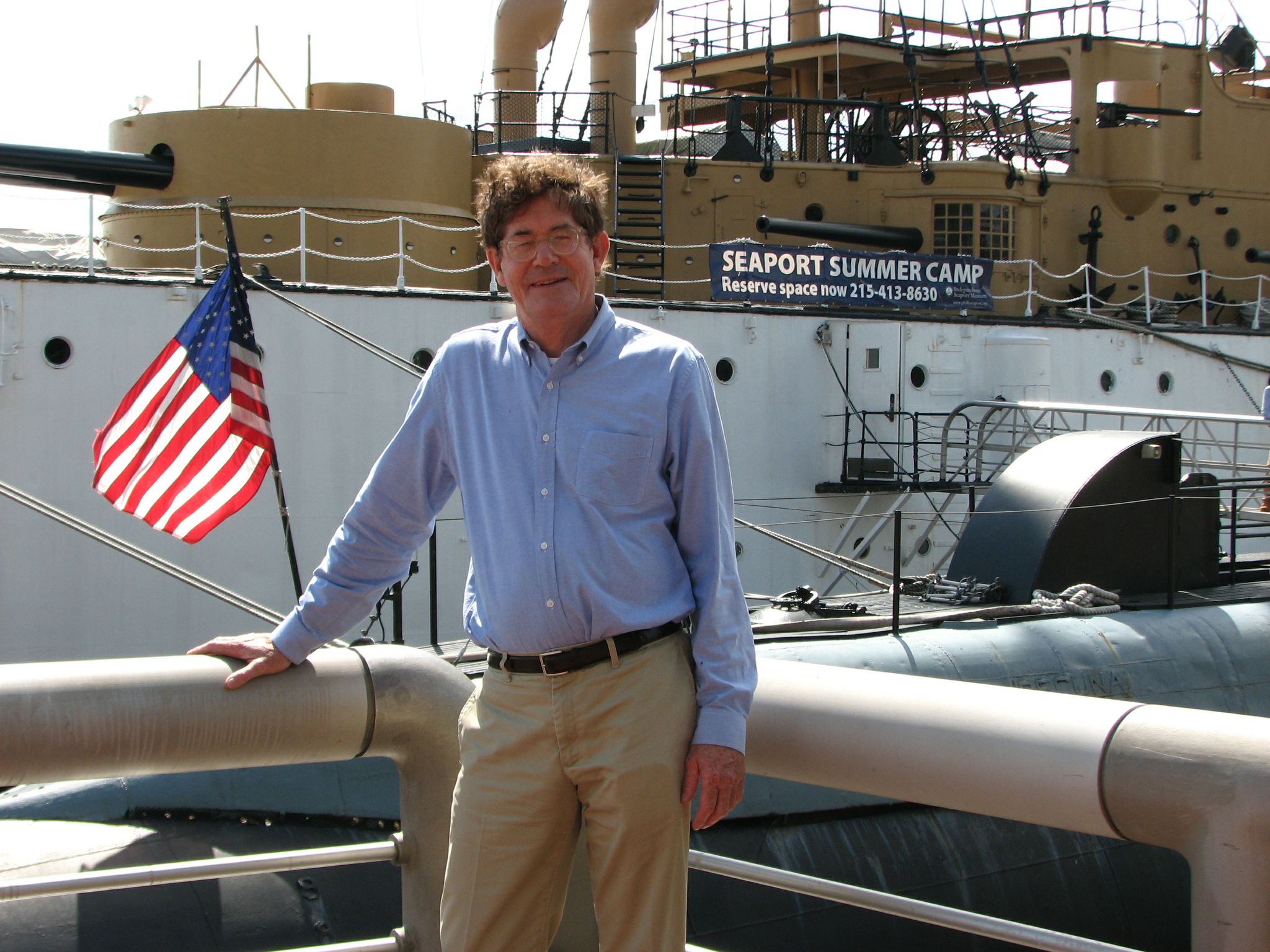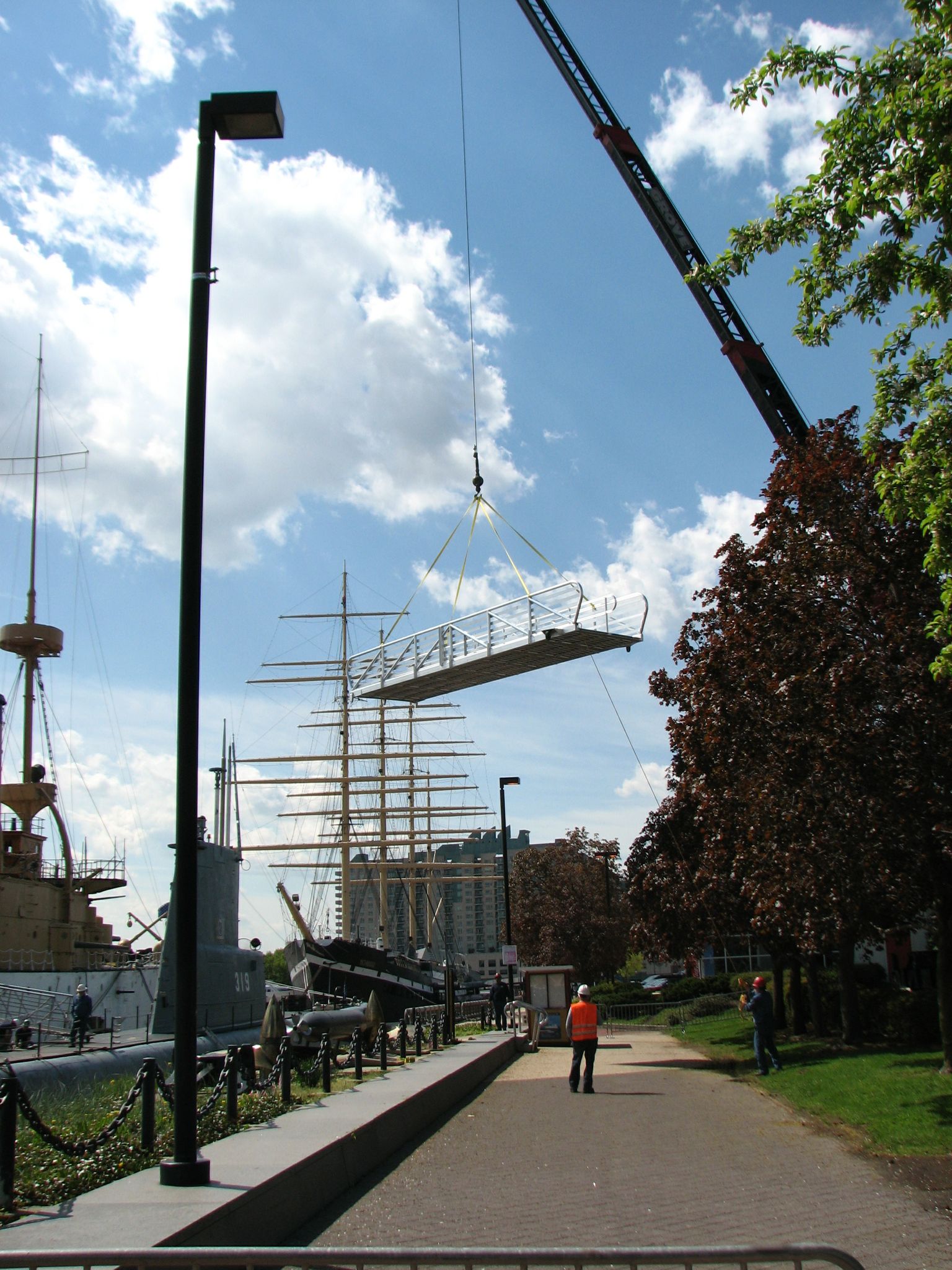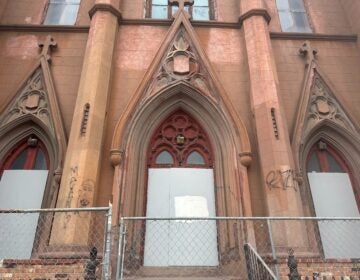Olympia looks to local community and national support to keep her afloat

A new gangplank was installed last week to welcome visitors aboard the Cruiser Olympia, a practical upgrade but also a symbolic gesture for Philadelphia’s most historic and long-beleaguered warship.
The hope is that a wave of support on the national level, buoyed by local visitors for a variety of events and programming – from weddings to family sleepovers to tattoo conventions — will save the ship, which is in need of millions in repairs if she is to stay afloat.
In April, the Independence Seaport Museum announced that a four-year effort to find a suitable steward in some other city to take Olympia had been unsuccessful.
The ship, it was decided, would stay at Penn’s Landing, where she has been moored since the 1950s. And a new plan would be launched to resuscitate and keep her here as a living museum of U.S. naval history.

Losing battles
Previous fundraising campaigns to preserve Olympia failed to gather steam. The last effort, in 2010, to raise $20 million to dredge the Penn’s Landing Marina, tow Olympia to dry dock, restore her deteriorating hull – which has been in the water for nearly 70 years – and assure her maintenance fell far short of its goal. The Navy gave the Seaport Museum the nod to “responsibly dispose” of Olympia. The leadership declared a new mission for the Seaport Museum that did not include maintenance of an aging warship.
Preservationists, sailors’ families, baby-boomers who toured Olympia as schoolchildren, and others objected to the idea of sinking the ship off the Jersey coast for use as a manmade reef. Other cities have given new life to important ships, including the Intrepid in New York, the USS Constitution in Boston, and a handful of historic vessels in Baltimore. Surely someone somewhere would want Olympia.
A transfer review panel was convened in 2011 with representatives from the Council of American Maritime Museums, Pennsylvania Historical and Museum Commission, National Trust for Historic Preservation, and the Seaport Museum. Organizations from throughout the United States expressed serious interest, and the field had been narrowed to two candidates: the South Carolina Olympia Committee in Beaufort, S.C., and Mare Island Historic Park in Vallejo, Calif. But the transfer committee found that neither organization had a viable, long-term solution for preserving the ship.
Setting a new direction
While the search for a new harbor for Olympia was waged, work continued on the ship. The Seaport Museum has been spending $250,000 a year on stabilizing her: reinforcing areas of the hull, installing a network of bilge pumping stand pipes to contain further damage in case of a breech, patching the deck, and recoating the hull and rig. According to the museum, Olympia is in better condition than she has been in years.
At the helm of this latest effort is John Brady, who seems as a tall as a mast and has the hands of a shipwright. In fact, Brady, who has been building and sailing boats since he was a boy, supervised the boat shop at the Seaport Museum from 1995 to 2011, when he was named Chief Executive Officer.
Brady doesn’t provide much detail regarding how and from where the money will come to preserve Olympia, but “we made the commitment to do it.”
The first step, he said, is the planning. “We’re talking to lobbyists about the best way to approach Washington, D.C., on this. We’re also investigating the best way to go after a national appeal for the ship.”
The immediate goal is to make Olympia “as appealing as possible to the public,” which involved the cosmetic as well as structural repairs. “At the end of the planning phase next year, I’ll be able to give you a full rundown on exactly how the capital campaign is going to be pursued,” Brady said. “It wasn’t possible to do all this when the future of the ship was in a state of flux. So what we’ve been doing over the last three years is setting the stage. We felt that whether we kept the ship or someone else got her, all of this work would greatly increase her chances of survival.”
Ship’s log
Brady believes Olympia’s story will open wallets in Washington and around the country. It is an impressive background:
Olympia was launched in San Francisco in 1892 and is the oldest steel warship still afloat in the world. She was Commodore George Dewey’s flagship at the Battle of Manila Bay, where Dewey uttered the iconic order, “You may fire when you are ready, Gridley.” Olympia devastated the Spanish fleet and raised up the U.S. as a world power.
Olympia went to service again during World War I, and carried home the body of the Unknown Soldier from France in 1921. She was decommissioned in 1922 and mothballed at the Philadelphia Navy Yard. In the 1950s, she was moved to Penn’s Landing and took on a new role as a floating museum.
Olympia has been declared a National Historic Landmark and a National Historic Mechanical Engineering Landmark (she was among the fastest ships of her time), and she is on the National Register of Historic Places.
Event venue
The ship is also a fascinating example of how 19th-century society was structured, Brady noted, and a new onboard exhibit of the sailors’ lives will take visitors from the cramped hammocks of the average seaman to the palatial quarters of the commodore. The exhibit will include the diaries and photos of the crew and items donated by their descendants. Special tours will also provide access to sections normally closed to the public, including the engine room.
The revenue plan also includes onboard art shows, sleepovers, cocktail parties, and other celebrations. A June wedding is booked, but it won’t be the first. An earlier ceremony was held during one of the annual tattoo conventions on the Olympia. What better place to get an anchor inked on your arm?
“Those are some of the ways we’re exploring how we tie this ship to the community around it,” Brady said. “We’re opening it up and exploring different possibilities.”
Repair of the ship could also be a “public show,” Brady said. The short-term goal is to raise $7 million for drydocking to stabilize the hull. Brady’s boat shop at the Seaport Museum was surrounded by glass to allow visitors to watch the building process. The same thing could be done “just around the corner” at the Philadelphia Navy Yard, where the drydocking would occur. “We’ll let the public see us restoring the ship, rather than doing it somewhere out of sight.”
The Baltimore model
A city that has made an art of interpreting naval history and preserving its maritime resources is a short cruise south of Philadelphia. The organization Historic Ships in Baltimore is the steward of the USS Constellation, a magnificent sloop-of-war; the US Submarine Torsk; US Coast Guard Cutter Taney, the Lightship 116 Chesapeake, and the Seven Foot Knoll Lighthouse. All are clustered around the highly trafficked Inner Harbor and are major tourist attractions.
Yet, it is “always a struggle” to find funds to preserve historic vessels, according to Christopher Rowsom, executive director of Historic Ships in Baltimore. “That struggle is multiplied by the number of ships and assets you have.
“You’d think there would be all sorts of people who would be interested in supporting” these historic resources, but “year after year, that’s not necessarily the case” for ships across the country, Rowsom said.
“If there’s any secret to our success, it’s that the city holds title to the vessels we have here. That doesn’t mean we have a blank check. We compete with a lot of other city programs. But we have managed to get city support and we’ve leveraged that into state support,” he explained.
Federal grants for historic ships have “pretty much dried up,” he said. “We’re all sort of living on the edge and wondering where the next dime will come from.”
The Constellation came close to being reefed in 1992, but state and city funding was found to save her. “We did a three-way matching program” that raised $9 million for restoration. Now the ship needs another $2 million for repairs. “These vessels should be in glass cases somewhere, and it’s always a challenge” to keep them afloat.
Baltimore’s other big advantage is that all the ships are at the Inner Harbor, and admission to the floating museums raises 75 percent of the cost of keeping them open. “We have to raise another half-million dollars to keep things operating, and that doesn’t include capital projects,” Rowsom said.
The Seaport Museum has done a great job at preserving Olympia, whose size takes her into another category that involves a larger facility for repairs and more resources to sustain her, he also said.
Philadelphia’s warship is “so important from a historical perspective,” said Rowsom, noting that she was called out in a recent article published by the National Maritime Heritage Society as one of the three most important and threatened ships in the nation, along with the Constellation and Constitution.
“There is only one of her. Not to discount the other vessels, but often there is more than one of a specific type of ship. Olympia has an amazing history. We all think it’s pretty important that she be around.”
Location, location
John Brady is familiar with the challenges facing Olympia. “We are not Baltimore and we’re not Boston. The harbor is at the center of Baltimore. The center of Philadelphia is Broad and Market Streets, 15 blocks away from this waterfront.”
He does like the urban planning he has seen for the Central Delaware, including the proposed capping of I-95 and a park that would connect the historic district with the river. “We see Olympia as a great Day 2 destination for history tourists. Someone who is in town to the Liberty Bell and Independence Hall – obviously, we’re not going to be better than that. But on the second day, we can be on the top of their list.”
As far as getting city funding like the Baltimore organization, Brady isn’t holding out hope. “Given the other problems that the city faces,” he said, “I don’t think they would see our ship as a priority.” The state Historical and Museum Commission has provided substantial support in the past, “but they have many historic sites to take care of.”
Brady’s faith is in the local community and the Olympia’s national appeal. He sees hope in the donation of $50 from a family in Peoria after it was announced that Philadelphia would keep the ship. And he has seen positive indicators from maritime organizations who have offered support for Olympia and the Seaport Museum’s national fundraising plan.
“My feeling about it is that this will be the first time that we made a serious effort on those stages,” he said.
At a recent conference on American warships, the participants discussed the creation of a national ranking system of historical importance, Brady said. “I’m not talking about condition – just how important a ship is to the United States. If there were a ranking system, say a Top Five, Olympia would be right up there. While every city has a ship of some significance, very few are on the level of this ship.” And that should be recognized by national funding sources, he said.
Besides all that, Brady added: “She is the coolest thing going.”
Contact the writer at alanjaffe@mac.com.

WHYY is your source for fact-based, in-depth journalism and information. As a nonprofit organization, we rely on financial support from readers like you. Please give today.






